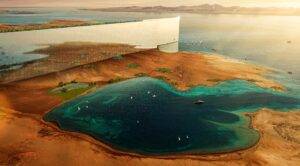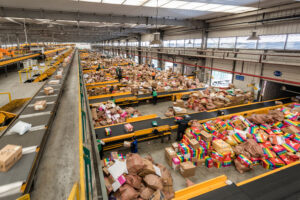Peter Cook & Yazan Al Homsi on The Line City: A Futuristic Blueprint and its Impact on Global Dynamics

<?xml encoding=”utf-8″ ?????????>
Dubbed “The Line,” this city of the future challenges traditional notions of urban spaces and casts a long shadow over Western cities known for their cultural and economic heft, such as London, New York, and Toronto. Spanning 170 kilometres and designed to house nine million people without cars, the linear city directly responds to contemporary issues of urban sprawl, environmental sustainability, and the shifting sands of global influence.
Tourism: Redrawing the Map of Attractions
“The Line promises a future where residents can traverse the entire city within a matter of minutes, not through congested highways, but through a seamless transport system that runs silently and efficiently beneath their feet,” says architect Yazan Al Homsi, envisioning a paradigm shift in city living. The project aims to carve out a new niche in the global tourism sector, currently dominated by historical and cultural heavyweights. Architect Peter Cook, associated with The Line’s design, envisions a structure that challenges both the technical and aesthetic aspects of modern architecture, potentially rivalling the allure of London’s architectural marvels or the natural grandeur of Canadian landscapes. The Line may reposition Saudi Arabia on the tourism map and redefine what constitutes a ‘must-visit’ destination.
Migration: A New Urban Magnet?
As major Western cities often represent opportunity and progress, The Line City seeks to become a new beacon for global migration. Its technologically advanced infrastructure and promise of a high-quality, environmentally-conscious lifestyle could shift migration patterns, traditionally directed towards established urban centres. But, as Kasparek wryly notes, “Soccer players and reporters are not a special case,” highlighting that the allure of new destinations often overshadows underlying socio-political issues. The Line’s success in attracting global citizens will depend on how it addresses these complex factors beyond the blueprint.
Global Warming: Setting a Sustainable Example
Global warming represents an existential threat, with cities worldwide grappling with carbon emissions and environmental degradation. “The buildings are imagined to be feats of engineering and sustainability – structures that are self-sufficient, powered by renewable energy,” Al Homsi highlights The Line’s commitment to a zero-carbon footprint, a stark contrast to the current energy-intensive cities in the Western hemisphere. If successful, The Line could serve as a compelling case study for cities like Los Angeles or Toronto, which are seeking pathways to sustainability while wrestling with the realities of modern urban life.
Economy: A New Economic Vision
The Line is not just a city; it’s a bold economic statement. By channelling investment into futuristic infrastructure, Saudi Arabia seeks to pivot from an oil-centric economy to one driven by innovation, potentially influencing global economic currents. The project’s success could attract a new wave of investment and challenge the financial landscapes of cities like New York or London. The extent to which The Line can impact the global economy will be watched closely by economists and policymakers alike.
Urban Design: Architectural Renaissance or Folly?
Finally, The Line’s architectural promise is staggering. It challenges existing urban centres to reimagine their future. “In The Line, I see the promise of a city that marries the age-old wisdom of living with the land, with the audacious aspirations of the future,” Al Homsi muses. It could trigger a renaissance in urban design, inspiring cities around the world to rethink how they use space, technology, and design to create sustainable, livable environments for their citizens. Yet, as with any grand architectural endeavor, there is a risk it could become a monument to hubris rather than human progress.
The Line City stands as a testament to Saudi Arabia’s vision of the future—ambitious, audacious, and untested. Its impact on tourism, migration, global warming, and the economy holds potential lessons for Western cities that grapple with similar issues. Whether The Line will draw people away from the established urban centers of the UK, USA, and Canada remains uncertain. Yet, its very conception challenges these cities to think linearly about their growth and sustainability. As The Line stretches across the Saudi desert, it also stretches the imagination of what might be possible, offering a glimpse of a new dawn for urban civilization or a mirage of ambition in the face of complex global realities. The world watches and waits, anticipating the ripple effects of this 1200-word story etched in steel, glass, and the indomitable human spirit.




